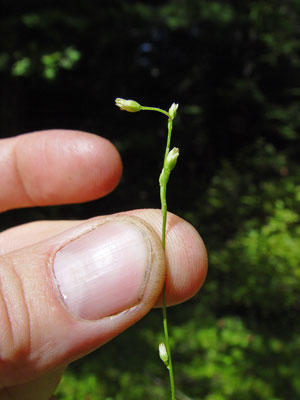DACF Home → Bureaus & Programs → Maine Natural Areas Program → Communities, Plants, and Animals → Rare Plants → Bartonia paniculata
Bartonia paniculata (Michx.) Muhl.

Screwstem
- State Rank: S1
- Global Rank: G5T3T5
- State Status: Threatened
Habitat: Wet peat and sand. [Coastal non-tidal wetland (non-forested, wetland)]
Range: Florida to Louisiana, north to southern New England and Nova Scotia, west through southern New York to Okalahoma.
Aids to Identification: The species is readily distinguished from Bartonia virginica (L.) BSP by alternate (rather than opposite) leaves below the inflorescense and a calyx that is cleft from 2/3 to nearly the base vs. lobed for B. virginica.
Ecological characteristics: Plants may be parasitic or hemiparasitic on the roots of other plants or trees.
Phenology: Flowers August to October. Tiny dust-like seeds are scattered in the wind in early autumn.
Family: Gentianaceae
Synonyms: Bartonia lanceolata Small; Bartonia virginica (L.) B.S.P. var. paniculata (Michx.) Boivin; Centaurella paniculata Michx.
Known Distribution in Maine: This rare plant has been documented from a total of 8 town(s) in the following county(ies): Cumberland, Hancock, Knox, Sagadahoc, York.
Reason(s) for rarity: Typical variety at northern limit of range in Maine; subspecies iodandra disjunct from main population.
Conservation considerations: Little is known about this species's population biology. Maintaining the natural hydrology of the wetlands in which it occurs is prudent.